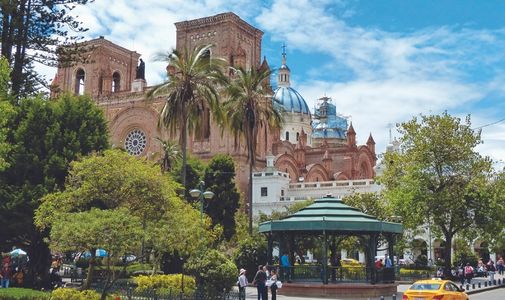Sandra H. Says:
How is the weather in Ecuador?
IL Ecuador Correspondent Donna Stiteler Says:
 If you like experiencing four seasons, then Ecuador may fit the bill. But as Ecuadorians say, the catch is the four seasons occur over the course of one day. It’s winter in the morning (50s F), by mid-morning it’s Spring (low 70s F), by noon its summer (high 70s F but feels 80s F in the sun), and late afternoon it’s Fall (60s F). Largely due to both the altitude and its proximity to the equator, Ecuador provides near-perfect weather no matter where you live.
If you like experiencing four seasons, then Ecuador may fit the bill. But as Ecuadorians say, the catch is the four seasons occur over the course of one day. It’s winter in the morning (50s F), by mid-morning it’s Spring (low 70s F), by noon its summer (high 70s F but feels 80s F in the sun), and late afternoon it’s Fall (60s F). Largely due to both the altitude and its proximity to the equator, Ecuador provides near-perfect weather no matter where you live.
The temperate climate ensures there’s no wide weather swings like you can experience in the U.S., with burning hot summers and freezing winters. Instead, the climate stays about the same pretty much all year round with minor temperature variances.
Every day, the sun rises at 6:30 a.m. and sets at 6:30 p.m., meaning the entire country enjoys 12 hours of direct equatorial daylight, 365 days a year.
Although Ecuador is one of the smallest countries in South America, the mainland (i.e., excluding the Galápagos Islands) actually has three distinct geographical regions, each with its own climate: the coast, the sierras (mountain highlands), and the oriente (the jungle). A benefit of being a small country: If you don’t like the weather, just jump to one of the other geographical regions to get the temperature you want.
The coast is usually 10 degrees warmer than the Andes with temperatures ranging from 60s to 80s, with the cool Humboldt Current providing a significant cooling effect, keeping the coastline from getting so hot your flip flops melt on the pavement.
In the Andes, altitude plays a big hand; the farther up you go on the mountain the cooler it’s going to be, so temperatures range from 50s F to 70s F. Unless you are climbing the high peaks of Ecuador’s Cotopaxi Mountain, the world’s tallest mountain, then you’re not going to see snow because the mountains are sitting on a heating pad, better known as the equator.
The time of year has the biggest impact on the weather variations: dry v. raining season. The dry season (winter) runs from June to September and the weather is generally sunny but cooler; and the wet season (summer) is from October to May and is typically a little warmer, but prone to afternoon thunderstorms. When it does rain in Ecuador, it doesn’t usually last all day long, but makes surprise appearances throughout the day with short overtures lasting around 30 minutes each.
As they say in Ecuador, “if you don’t like the weather, just wait 15 minutes, and it will change.”
Editor’s Note: If you’re seriously considering Ecuador as a new home (and with all it has to offer, why wouldn’t you?), then you should check out the article Donna wrote for our Ecuador Insider: 16 Things I Wish I’d Known Before Moving to Ecuador.

